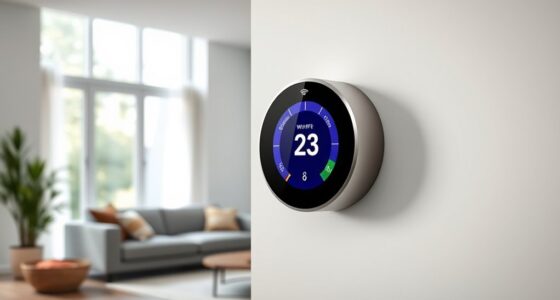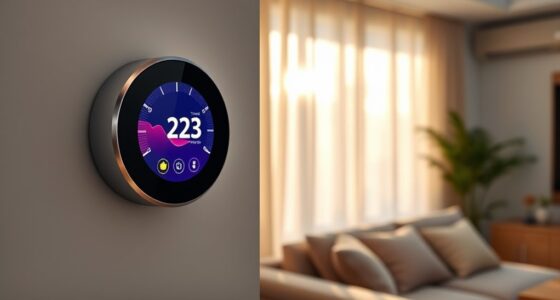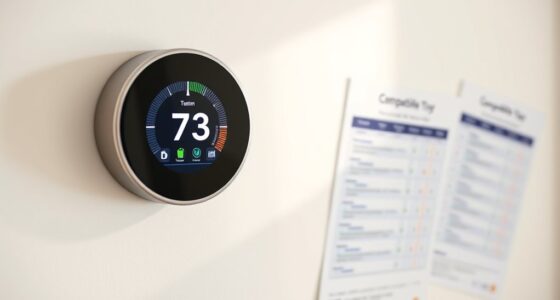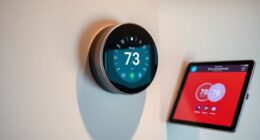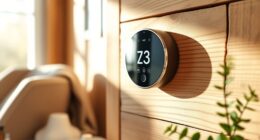Thermostat data helps power grids balance load by providing real-time information on energy consumption patterns. It enables utility companies to monitor demand and adjust thermostat settings during peak times, reducing strain on the grid. This seamless communication helps prevent overloads and supports more efficient energy use. By using this data, the grid becomes more reliable and sustainable. To discover how this technology shapes a smarter energy future, keep exploring this topic further.
Key Takeaways
- Thermostat data provides real-time insights into energy consumption patterns, enabling better demand forecasting.
- It helps utilities identify peak usage times and plan grid resources accordingly.
- Automated adjustments based on thermostat data reduce load during high-demand periods through demand response.
- Analyzing usage patterns supports infrastructure improvements and integration of renewable energy sources.
- Sharing thermostat data allows for dynamic load balancing, preventing overloads and enhancing grid stability.

Thermostat data plays an essential role in optimizing power grid performance by providing real-time insights into energy consumption patterns. When you use smart thermostats, you give utility companies a powerful tool to monitor and manage electricity demand more effectively. These devices collect detailed data on how and when your heating and cooling systems operate, allowing the grid to better anticipate peak usage times. With this information, utilities can implement demand response strategies, which encourage you to adjust your thermostat settings during periods of high demand. This coordinated effort helps prevent overloads and reduces the need for additional power plants, making the entire grid more efficient.
Smart thermostats provide real-time energy data that helps optimize grid performance and prevent overloads.
By participating in demand response programs, you directly contribute to balancing the load on the power grid. When energy consumption surges, your smart thermostat can automatically adjust the temperature within a comfortable range, reducing strain on the system without sacrificing your comfort. These adjustments happen seamlessly, often based on signals from your utility, which communicates during times of peak demand. As a result, you save on energy costs and support a more sustainable energy system. This real-time communication between your thermostat and the grid ensures that electricity is distributed where it’s needed most, avoiding blackouts or brownouts caused by sudden demand spikes.
Furthermore, the data collected from smart thermostats allows utilities to plan better for future energy needs. They analyze this information to identify patterns, such as seasonal changes or daily peaks, which helps in designing smarter, more resilient grid infrastructure. You benefit by having a more reliable power supply, fewer outages, and potential financial incentives for participating in demand response programs. The integration of thermostat data also promotes the growth of renewable energy sources by smoothing out fluctuations in supply and demand, ultimately leading to a greener energy ecosystem.
In addition, advancements in Kia Tuning technologies demonstrate how data-driven adjustments can optimize performance, similar to how utilities optimize grid operations with thermostat data. In essence, your smart thermostat acts as both a personal comfort device and a key component in modern energy management. It enables your utility to fine-tune grid operations in real-time, ensuring a balanced, efficient, and resilient power system. Your participation in demand response not only helps you save money but also supports broader efforts to stabilize the grid and incorporate renewable energy sources. As technology advances, the importance of thermostat data in power grid management will only grow, making your everyday actions more impactful in shaping a sustainable energy future.
Frequently Asked Questions
How Is User Privacy Protected When Collecting Thermostat Data?
When your thermostat data is collected, privacy safeguards come into play to protect your information. Data encryption guarantees your data is secure during transmission and storage, preventing unauthorized access. Additionally, manufacturers often anonymize or aggregate data, so your personal details remain private. These measures give you peace of mind, knowing your usage patterns are analyzed only for improving system efficiency without compromising your privacy.
Can Thermostat Data Predict Future Energy Consumption Patterns?
Thermostat data can predict your future energy consumption patterns through behavior prediction and energy forecasting. By analyzing your usage habits, it identifies trends and anticipates changes in your heating or cooling needs. This helps utilities optimize power generation and distribution, ensuring a reliable supply. As you adjust your thermostat, it contributes valuable insights that refine these forecasts, making energy management more efficient and tailored to your lifestyle.
What Are the Challenges in Integrating Thermostat Data With Grid Systems?
You face challenges in integrating thermostat data with grid systems due to data standardization issues and the need for real-time synchronization. Different thermostat brands may use varying data formats, making seamless integration difficult. Additionally, ensuring real-time data flow demands robust communication infrastructure. Overcoming these hurdles is vital for accurate load balancing, so you need standardized protocols and reliable, low-latency connections to optimize grid performance effectively.
How Do Different Types of Thermostats Vary in Data Accuracy?
Think of thermostats as different musical instruments, each producing unique sounds. Similarly, their data accuracy varies due to sensor calibration and hardware differences. Some thermostats, like smart models, maintain better calibration, providing reliable data. Others may need frequent calibration to guarantee accuracy. Data standardization helps align these differences, making sure grid systems interpret the information correctly. This consistency is essential for balancing loads efficiently and avoiding mismatched signals.
Are There Regulations Governing the Use of Thermostat Data for Grid Management?
You should know that regulations on using thermostat data for grid management focus on addressing privacy concerns. Authorities often require data anonymization to protect your identity and safeguard your privacy is maintained. These rules aim to prevent misuse of personal information while allowing utilities to optimize energy distribution. By complying with such regulations, grid operators can effectively use thermostat data, balancing energy loads without compromising your privacy rights.
Conclusion
By harnessing thermostat data, you become a conductor guiding the symphony of the power grid. Your smart thermostat whispers secrets of your comfort, helping the grid dance smoothly through peaks and valleys. This invisible choreography keeps lights shining bright and appliances humming. So, next time your thermostat adjusts, remember, you’re part of a larger orchestra—balancing the energy flow like a maestro, ensuring everyone’s needs are met without missing a beat.


